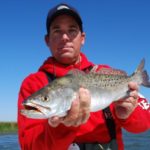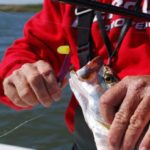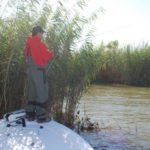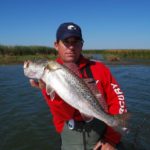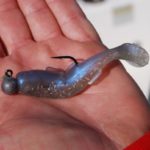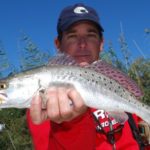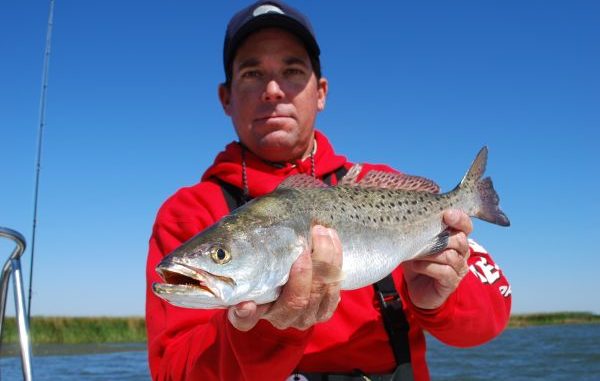
Many anglers believe consistently catching trout is complicated, but this Venice guide says there’s no reason to over-think your approach.
I can’t remember exactly where I was when someone first told me “Keep it simple, Stupid.” I do distinctly remember that I was a little insulted — being called “Stupid,” and all that.
I remember bowing up and the speaker having to explain that it was simply a figure of speech he often used to remind himself not to over-think something.
It was probably some of the best advice I have ever gotten.
Lots of times simple is best, although it can be hard to convince some fishermen of that — especially bass and speckled trout anglers.
Admittedly, specks can be a challenge. Here today; gone tomorrow. When you do find them, the bite can be ferocious and then boom — it just shuts off — for no apparent reason.
You want to keep casting at that spot, thinking, “They just have to still be there.”
So a lot of anglers begin changing lure colors — looking for that magic color that will pry that reluctant mouth open. When that doesn’t work, they have an answer. They make a trip to the tackle store to buy more colors for their next trip.
Their tackle boxes look like rainbows. And lure makers love it!
What do the pros — those charter guides who rely on catching fish to make their living — do? It is easy to assume that hidden in the recesses of their bay boats’ compartments are every lure and color known to work in Louisiana.
Never mind that they have one bag with one color of plastic tail tossed up on their console. You tell yourself that that just happens to be the color of the minute and they know this because they fish every day.
“There is no way they fish with this one color year round,” you think.
Or do they?
A winter trip to Venice with speckled trout specialist Nash Roberts IV reminded me to “keep it simple, Stupid” all over again.
As he idled his boat out of Cypress Cove Marina, the youthful but experienced guide confided his approach.
“I like to come down here when it is cold and windy, but the river is low,” Roberts said. “There are a lot of canes to block the wind, and the water’s deep.”
The canes he is talking about are rosseau canes, the 10- to 15-foot-tall grasses that are the signature plants of the Mississippi River delta. And the reason he likes the deep water is that specks will keep biting in it, almost no matter how cold it gets.
As Roberts’ 22-foot Blackjack shot out of the Mississippi River into Main Pass, a huge black wild hog hustled from the water’s edge into the canes. In the cold, crystalline air, the edges of the grasses seemed etched against the blue sky. Everything seemed like it was in extra-sharp focus. Even the waves were defined in diamond brilliancy in the early morning air.
He had explained earlier that he would be focusing his fishing on the small passes, locally called cuts or spillways, off of the river’s major passes. Called ‘distributaries” by hydrologists, they pull water from the passes or the river itself and shunt it into open bay waters connected to the Gulf of Mexico.
The entrances to these cuts from the pass are usually deeply scoured by surging currents during the river’s high-water stages in the spring. These deep spots hold speckled trout during the low water of the early winter.
As he approached the first cut on the left, the north side of the pass, he slowed the boat, and then shook his head. Two boats were already in it.
“Been catching some nice ones in there,” Roberts grunted.
After passing several more cuts, he stopped outside of one on the right side of the pass. Quietly, he dropped his trolling motor and sneaked into the 25-yard-wide cut.
His tactic, which didn’t vary all day, was to circle round and round in the mouth of each cut, steadily casting plastic on a 3/8-ounce jighead as he circled. He retrieved the jig with a slow bouncing action that was more bouncing than retrieving.
As he fished, he explained that when fish turn up in the cuts, they can be caught on both rising and falling tides. The bite typically starts the last week of October and lasts until the Mississippi River comes up, which he defined as 5 feet on the New Orleans gauge. That can be November, or it can be January.
“I’ve often wondered where those trout go when the river rises,” he mused.
This cut produced nothing. He picked up and went back up the pass to one of the cuts he passed on the north side earlier.
Nothing again. Then he went to a second one. Same result.
He didn’t seem the least bit worried.
At the next cut, his rod bowed deeply on his first cast. He shook his head and gave a smirky grin. It was a 10- or 11-pound redfish.
“Humph,” he feigned indignation. “A redfish where trout are supposed to be!”
It went into the box.
So it went, cut after cut. He swept the mouth of each cut with casts. Some cuts were so small that he couldn’t take his boat into them. These he fished from the outside. Most were only an underhanded flip-cast wide.
None produced fish.
His concentration on the lure on the end of the line was so intense it could melt steel.
“One thing about down here: Any one of these spots could be the mother lode,” he said.
He hopped through Delta Duck oil field into Octave Pass. Still nothing.
One lonesome redfish resided in the ice chest. Lesser anglers would have begun changing tactics and lures. Most would probably just have given up.
Finally, in a cut off of Dead Woman Pass, he felt the thump he wanted and torqued his lean frame into a hook set. A beautiful speckled trout broke the surface, shaking its head violently.
Another followed this one, and then another.
“The secret is to move until you find the fish,” Roberts coached. “If they aren’t in your A spot, you move until you find them or run out of gas.
“I only spend 10 to 15 minutes in a spot and make 25 or 30 casts.
Unsaid in the lecture was, “Don’t sit plunked in one spot, changing bait colors, just because you caught them there last time.”
This stop netted him a half a limit.
The very next stop, a cut off of Brant Bayou, filled out his quota. As he stowed his rod, he grinned.
“I can promise you that at this time of the year, when you catch a speckled trout in 20 feet of water, he’s not the only one there.
Nash Roberts IV is a featured angler in the new book Trout Masters Too: How the Pros Do It, available at www.shop.lasmag.com and Amazon, as well as for Kindles. Roberts can be reached at the business he shares with his father, Fishhunter Guide Service, at 504-650-1918 or nashrobertsIV@hotmail.com.
